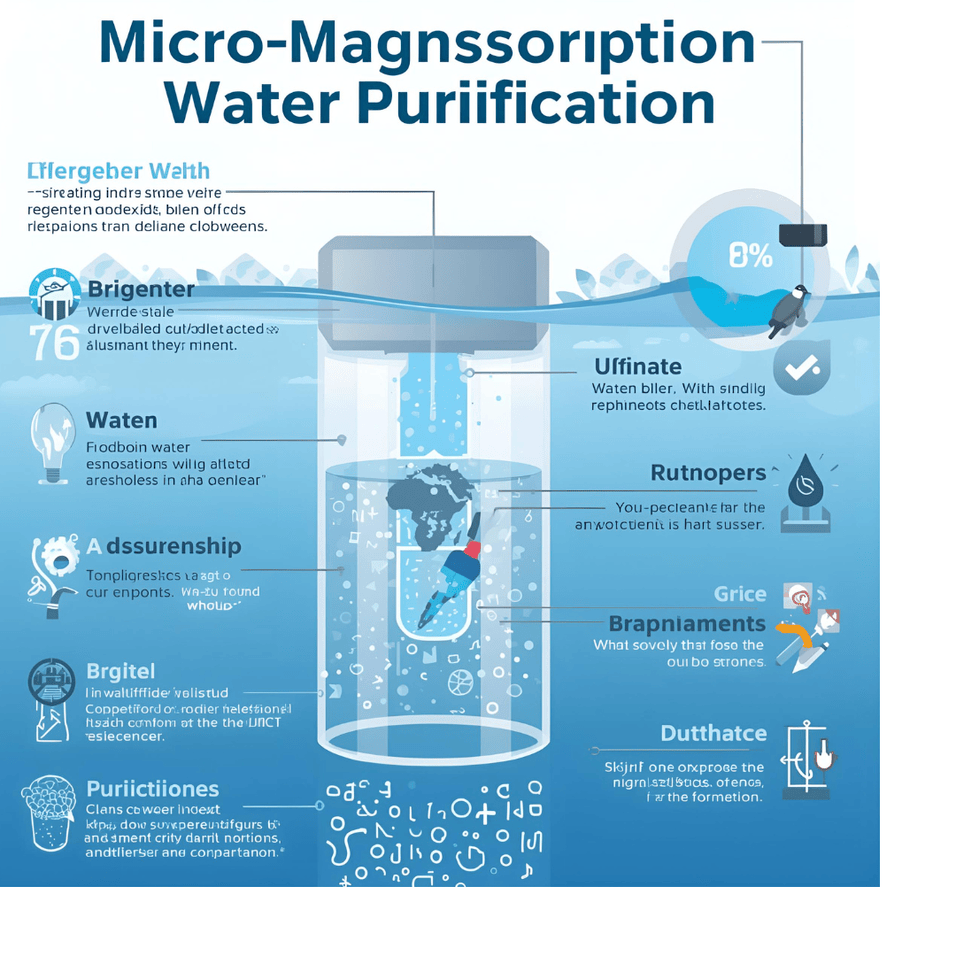
How Magsorption Water Purification Works: Complete 2025 Technology Guide
Clean water isn’t a luxury—it’s a basic human necessity. Yet millions of people worldwide still struggle with contaminated water sources that threaten their health every single day. Traditional filtration methods help, but they’re not always fast, affordable, or effective against modern pollutants.
Enter magsorption water purification, a breakthrough technology that’s changing how we think about making water safe to drink. This method combines magnetic technology with advanced chemistry to remove dangerous contaminants quickly and efficiently. It sounds futuristic, but it’s already being used in households, industries, and emergency situations around the world.
If you’ve heard about magnetic water treatment but aren’t quite sure how it works or whether it’s right for you, this guide breaks down everything you need to know in plain language.
What Is Magsorption Water Purification?
Magsorption water purification is a water treatment process that involves the use of small sized magnetic particles to collect and eliminate the pollutants in the impure water. The name is an amalgamation of the terms magnetic and adsorption the sticking of molecules to a surface.
Consider it as picking up metal shavings on a work bench with a magnet. In magsorption water purification, the magnetic particles which are specially designed play the same role as those magnets except that they do not collect the metal shavings as the magnets do, but they collect the harmful chemicals such as heavy metals, chemicals and organic water dissolved chemicals.
This is a simple technology that is beautiful. You put magnetic particles into dirty water, they attach to contaminants, and then you extract the particles (and the contaminants attached to them) off of the water with a magnet. The rest is clean and safe water.
Compared to the usual filters which physically force water through filters, magsorption water purification operates at a molecular scale. This renders it extremely successful in the capture of contaminants missed by other techniques.
The Science Behind Magnetic Adsorption Technology
You can not know about magsorption water purification without knowing what adsorption is. It is not like absorption, where a substance washes into a substance such as a sponge. Adsorption is the process that occurs when molecules are bound on the surface of another substance.
The magnetic particles that are employed in the magsorption purification of water are designed in such a way that they have special surface properties. Scientists make these surfaces appealing to certain forms of contaminants. When such particles are exposed to contaminated water, the pollutants naturally attach to them.
And there is the critical part of the magnetic part: after the particles are covered in pollutants, there must be an easy method of extracting them out of the water. That is where magnetism comes in. You can pull the particles very fastly out of the water in one operation by applying a magnetic field to it.
This procedure is quite effective. In traditional filtration, the water flows through physical obstacles to filter, which may become clogged with time and need a replacement after a short period. This is not the issue with magsorption water purification in that there is no wall and all particles are floating on their own merit, performing their duty and being taken away by a magnet.
How Magsorption Water Purification Actually Works
Let’s walk through the complete process step by step so you can see exactly what happens during magsorption water purification.
Step 1: Preparation of Magnetic Adsorbents
Scientists create tiny magnetic particles, usually in the micro or nano size range. These particles are made from materials like iron oxide and are coated with substances that help them attract specific pollutants. The coating can be customized depending on what contaminants need to be removed.
Step 2: Introduction into Contaminated Water
These prepared magnetic particles are added to water that contains pollutants. The amount added depends on how contaminated the water is and what types of pollutants are present. Too few particles won’t capture everything; too many waste resources.
Step 3: Adsorption Phase
Once in the water, the particles begin attracting contaminants to their surfaces. Heavy metals like lead, arsenic, and mercury bind strongly to the particle surfaces. Organic pollutants, dyes from industrial waste, and other harmful substances also attach. This happens relatively quickly—often within minutes.
Step 4: Magnetic Separation
After giving the particles enough time to capture contaminants, a magnetic field is applied. This can be as simple as placing a strong magnet near the water or using specialized magnetic separation equipment. The magnetic particles, now loaded with pollutants, are pulled toward the magnet and removed from the water.
Step 5: Recovery or Disposal
The collected particles with attached contaminants can either be disposed of safely or, in many cases, regenerated. Regeneration involves treating the particles to release the captured pollutants, cleaning them, and reusing them for another purification cycle. This makes magsorption water purification economically sustainable.
Key Benefits of Magsorption Water Purification Systems
Magsorption water purification offers advantages that traditional methods struggle to match. Understanding these benefits helps you see why this technology is gaining attention worldwide.
Highly Effective Contaminant Removal
Magsorption water purification excels at removing heavy metals like arsenic, lead, cadmium, and mercury—contaminants that pose serious health risks even in small amounts. It also effectively removes organic pollutants, industrial chemicals, and certain microorganisms. The adsorption happens at a molecular level, meaning even dissolved contaminants that slip through traditional filters get captured.
Fast Processing Time
Traditional filtration can be slow, especially when dealing with large volumes of water. Magsorption water purification works quickly because the magnetic particles have large surface areas and can adsorb contaminants rapidly. The magnetic separation phase is almost instantaneous once adsorption is complete.
Reusable Materials
Unlike disposable filters that end up in landfills, the magnetic particles used in magsorption water purification can often be regenerated and reused multiple times. This significantly reduces long-term costs and environmental waste. You’re not constantly buying replacement cartridges or filters.
Scalable for Different Needs
Magsorption water purification works equally well for small household systems and large industrial treatment plants. The same basic principles apply regardless of scale. This versatility makes it suitable for diverse applications—from purifying water in a single home to treating wastewater from factories.
No Chemical Additives Required
Many water purification methods require chemical additives that can themselves become contaminants if not properly managed. Magsorption water purification is a physical process that doesn’t necessarily require adding chemicals, making the treated water safer and more natural.
Lower Energy Consumption
Compared to methods like reverse osmosis, which require significant energy to force water through membranes, magsorption water purification uses relatively little energy. The main energy requirement is for the magnetic separation, which is minimal.
Real-World Applications and Use Cases
Magsorption water purification isn’t just theoretical—it’s being used right now in various contexts around the world.
Household Water Treatment
Families living in areas with contaminated groundwater benefit enormously from magsorption water purification systems. These can be small-scale units that treat water before it reaches household taps. They’re particularly valuable in regions where arsenic or other heavy metals naturally occur in groundwater.
Installation is straightforward, and maintenance is minimal compared to traditional filters. Homeowners appreciate not having to replace expensive cartridges every few months.
Industrial Wastewater Treatment
Factories that produce wastewater containing heavy metals, dyes, or chemical residues use magsorption water purification to clean water before releasing it back into the environment. This helps companies meet environmental regulations while reducing their ecological footprint.
Industries particularly suited for this technology include textile manufacturing, electroplating, mining operations, and chemical production. The ability to remove specific contaminants efficiently makes it ideal for these applications.
Rural and Remote Communities
Communities without access to centralized water treatment infrastructure benefit significantly from magsorption water purification. The technology can be deployed in portable systems that don’t require complex infrastructure or constant electricity.
Aid organizations and government programs use magsorption water purification to provide clean water in areas where building traditional treatment plants isn’t feasible.
Emergency and Disaster Relief
Response is urgent when natural disasters pollute water supplies. Water purification by magsorption systems can be set up in an emergency within a very short period to supply potable water. They are very portable and readily usable during disaster relief missions.
Flooding that pollutes the wells or damages infrastructure that interrupts the water treatment, magsorption water purification is a sure back-up measure.
Magsorption vs Traditional Water Filtration Methods
Understanding how magsorption water purification compares to other methods helps you appreciate its unique advantages.
Magsorption vs Mechanical Filtration
Traditional filters use physical barriers with tiny pores to trap contaminants. They work well for particles but struggle with dissolved substances. Magsorption water purification captures both particulate and dissolved contaminants at the molecular level. Additionally, filters clog and need frequent replacement, while magnetic particles can be regenerated.
Magsorption vs Reverse Osmosis
Reverse osmosis forces water through semi-permeable membranes under high pressure. It’s very effective but energy-intensive and wastes significant amounts of water. Magsorption water purification uses less energy and wastes less water. However, reverse osmosis removes a broader range of contaminants, including salts, which magsorption may not address as effectively.
Magsorption vs Chemical Treatment
Chemical treatments like chlorination kill microorganisms but don’t remove heavy metals or many organic pollutants. They also leave chemical residues in water. Magsorption water purification removes physical contaminants without adding chemicals, though it may need to be combined with disinfection methods for complete microbial safety.
Magsorption vs Activated Carbon
Activated carbon adsorbs many organic chemicals and improves taste and odor. However, it’s less effective against heavy metals and inorganic contaminants. Magsorption water purification excels at removing heavy metals. The ideal solution often combines both methods for comprehensive purification.
Step-by-Step Implementation Guide
If you’re considering implementing magsorption water purification, here’s what the process looks like.
Assess Your Water Quality
Test your water to determine some of the contaminants before applying any treatment system. This knowledge can assist in selecting the appropriate kind of magnetic adsorbents whether they are heavy metals, organic pollutants or other elements.
Home water testing can be done by buying kits or getting professional assistance to do in-depth analysis. Knowing levels of contamination also guide you on the dosage of the magnetic particles to use.
Select Appropriate Magnetic Adsorbents
Not all magnetic adsorbents work equally well for all contaminants. Some are specifically designed for heavy metals, while others target organic pollutants or dyes. Choose adsorbents tailored to your specific contamination issues.
Consult with suppliers or experts who can recommend the right products based on your water test results.
Determine Proper Dosage
The amount of magnetic adsorbent needed depends on water volume and contamination levels. Too little won’t remove all contaminants; too much wastes materials and money. Manufacturers typically provide dosage guidelines based on contamination type and concentration.
Start with recommended amounts and adjust based on results from testing treated water.
Set Up Mixing and Contact Time
To be effective, magsorption water purification requires magnetic particles to have sufficient contact time with polluted water. This typically consists of stirring the particles in the water and letting the particles circulate in the water in a number of minutes.
Small volumes can be stirred by hand. Even larger systems can rely on mechanical mixers or circulation pumps to guarantee equal distribution.
Apply Magnetic Separation
Once adsorption is complete, apply a magnetic field to collect the particles. Small-scale systems might use permanent magnets placed strategically in the water flow. Larger systems employ electromagnetic separators that can be turned on and off as needed.
The separated particles, now loaded with contaminants, are collected for disposal or regeneration.
Test Treated Water
Always verify that treated water meets safety standards. Test for the specific contaminants you were targeting to ensure the magsorption water purification process worked effectively. Adjust your process if contaminant levels remain too high.
Common Challenges and How to Overcome Them
Like any technology, magsorption water purification comes with challenges. Knowing them in advance helps you avoid problems.
Challenge: Incorrect Dosing
Using too few magnetic particles leaves contaminants in water. Using too many wastes resources without improving results. Solution: Follow manufacturer guidelines carefully and adjust based on water testing results. Keep detailed records of dosage and outcomes to find the optimal amount.
Challenge: Incomplete Mixing
If magnetic particles don’t distribute evenly throughout the water, some contaminants won’t be captured. Solution: Ensure adequate mixing time and use mechanical stirring for larger volumes. Avoid rushing the adsorption phase.
Challenge: Inefficient Magnetic Separation
Weak magnets or improper placement can leave particles suspended in water. Solution: Use appropriately strong magnets positioned correctly for complete separation. In larger systems, invest in quality electromagnetic separation equipment.
Challenge: Particle Loss During Regeneration
When regenerating magnetic particles for reuse, some material is inevitably lost, reducing efficiency over time. Solution: Follow regeneration procedures carefully to minimize loss. Eventually, you’ll need to replace particles, but proper handling extends their usable life.
Challenge: pH Sensitivity
Adsorption efficiency can be affected by water pH levels. Some contaminants bind better at certain pH ranges. Solution: Monitor and, if necessary, adjust water pH before treatment. This ensures optimal adsorption conditions.
Cost Analysis: Is Magsorption Water Purification Worth It?
Understanding the economics helps determine whether magsorption water purification makes sense for your situation.
Initial Investment
Small household systems might cost several hundred dollars, while industrial-scale installations can run into thousands or more. The initial cost includes magnetic adsorbents, separation equipment, and any necessary mixing apparatus.
Compared to installing reverse osmosis systems or building traditional filtration infrastructure, magsorption water purification often represents a moderate investment.
Operating Costs
Daily operating costs are relatively low. The main expense is replacing or regenerating magnetic adsorbents. If you regenerate particles effectively, a single batch can last for many treatment cycles. Energy costs are minimal since magnetic separation doesn’t require much power.
Long-Term Savings
The ability to reuse magnetic particles dramatically reduces long-term costs compared to disposable filters. Over years of operation, savings can be substantial. Additionally, avoiding health problems caused by contaminated water saves on medical expenses.
Return on Investment
For households dealing with contaminated water, the health benefits alone justify the cost. For industries, magsorption water purification helps meet environmental regulations, avoid fines, and potentially allows water reuse, providing clear economic benefits.
Future Trends in Magsorption Technology
Magsorption water purification continues to evolve, with exciting developments on the horizon.
Nano-Magnetic Particles
Researchers are developing even smaller magnetic particles at the nanoscale. These have vastly larger surface areas relative to their size, meaning they can adsorb even more contaminants. Nano-magsorption could make the technology significantly more efficient.
Bio-Magnetic Adsorbents
Scientists are creating magnetic adsorbents from biological materials, making them more environmentally friendly and potentially biodegradable. These bio-based materials could offer similar effectiveness while reducing environmental impact.
Hybrid Systems
Future systems will likely combine magsorption water purification with other technologies like UV disinfection, membrane filtration, or activated carbon to create comprehensive treatment solutions addressing all types of contamination.
Smart Monitoring
Integration with sensors and IoT technology will enable real-time monitoring of water quality and treatment efficiency. Systems could automatically adjust dosages, alert users to problems, and optimize performance without manual intervention.
Targeted Adsorbents
Development of highly specialized magnetic adsorbents designed for specific emerging contaminants—like pharmaceutical residues or microplastics—will expand magsorption water purification capabilities.
Environmental Impact and Sustainability
Magsorption water purification aligns well with global sustainability goals.
Regeneration and reuse capability of the magnetic particles cut down on waste over the disposable filter systems. Fewer waste materials will result in few environmental burdens. Another environmental benefit is energy efficiency. The benefit of consuming less energy is that there is less carbon emission which is critical in commercial use.
Magsorption water purification can protect the environment by inhibiting industrial pollution of its ecosystem by successfully eliminating contaminants prior to the discharge of water into the environment. Healthy rivers, lakes and oceans are achieved with cleaner discharge water.
The technology also minimizes the use of chemical treatments which also come with their own environmental effects. Removal of contaminants physically is more eco-friendly in nature as compared to chemical modification or neutralization.
Final Thoughts
Magsorption water purification is one of the great steps toward the availability of clean water, which is affordable and sustainable. Through the integration of the strength of magnetic technology with advanced surface chemistry, it is a process that eliminates hazardous contaminants in an economical manner.
It may be a homeowner who questions how well the water they drink in their home is; an industrial facility manager who would like to have a better wastewater treatment; or an aid worker who would like to help communities to receive clean water; magsorption water purification is a practical solution that really works.
The technology is not flawless since no one solution fits all problems of water quality. However, when properly utilized, magsorption water purification offers highly effective contamination removal that competes or outperforms conventional water purification techniques and has the benefits of affordability, sustainability, and simplicity.
With the current research and the further development of the technology, the magsorption water purification is bound to gain even more applicability and effectiveness. In the meantime, it is already one of the most promising methods of handling the global clean water issue.



